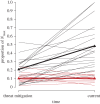Thresholds for impaired species recovery
- PMID: 26213739
- PMCID: PMC4590454
- DOI: 10.1098/rspb.2015.0654
Thresholds for impaired species recovery
Abstract
Studies on small and declining populations dominate research in conservation biology. This emphasis reflects two overarching frameworks: the small-population paradigm focuses on correlates of increased extinction probability; the declining-population paradigm directs attention to the causes and consequences of depletion. Neither, however, particularly informs research on the determinants, rate or uncertainty of population increase. By contrast, Allee effects (positive associations between population size and realized per capita population growth rate, r(realized), a metric of average individual fitness) offer a theoretical and empirical basis for identifying numerical and temporal thresholds at which recovery is unlikely or uncertain. Following a critique of studies on Allee effects, I quantify population-size minima and subsequent trajectories of marine fishes that have and have not recovered following threat mitigation. The data suggest that threat amelioration, albeit necessary, can be insufficient to effect recovery for populations depleted to less than 10% of maximum abundance (N(max)), especially when they remain depleted for lengthy periods of time. Comparing terrestrial and aquatic vertebrates, life-history analyses suggest that population-size thresholds for impaired recovery are likely to be comparatively low for marine fishes but high for marine mammals.Articulation of a 'recovering population paradigm' would seem warranted. It might stimulate concerted efforts to identify generic impaired recovery thresholds across species. It might also serve to reduce the confusion of terminology, and the conflation of causes and consequences with patterns currently evident in the literature on Allee effects, thus strengthening communication among researchers and enhancing the practical utility of recovery-oriented research to conservation practitioners and resource managers.
Figures


Similar articles
-
Empirical links between natural mortality and recovery in marine fishes.Proc Biol Sci. 2017 Jun 14;284(1856):20170693. doi: 10.1098/rspb.2017.0693. Proc Biol Sci. 2017. PMID: 28615502 Free PMC article.
-
Allee effect and the uncertainty of population recovery.Conserv Biol. 2014 Jun;28(3):790-8. doi: 10.1111/cobi.12216. Epub 2014 Feb 11. Conserv Biol. 2014. PMID: 24512300
-
Detection of Allee effects in marine fishes: analytical biases generated by data availability and model selection.Proc Biol Sci. 2017 Aug 30;284(1861):20171284. doi: 10.1098/rspb.2017.1284. Proc Biol Sci. 2017. PMID: 28855368 Free PMC article.
-
Red flags: correlates of impaired species recovery.Trends Ecol Evol. 2012 Oct;27(10):542-6. doi: 10.1016/j.tree.2012.06.005. Epub 2012 Jul 9. Trends Ecol Evol. 2012. PMID: 22784411 Review.
-
Biology of extinction risk in marine fishes.Proc Biol Sci. 2005 Nov 22;272(1579):2337-44. doi: 10.1098/rspb.2005.3281. Proc Biol Sci. 2005. PMID: 16243696 Free PMC article. Review.
Cited by
-
Ten principles from evolutionary ecology essential for effective marine conservation.Ecol Evol. 2016 Feb 28;6(7):2125-38. doi: 10.1002/ece3.2012. eCollection 2016 Apr. Ecol Evol. 2016. PMID: 27069573 Free PMC article. Review.
-
Recovery of critically endangered Nassau grouper (Epinephelus striatus) in the Cayman Islands following targeted conservation actions.Proc Natl Acad Sci U S A. 2020 Jan 21;117(3):1587-1595. doi: 10.1073/pnas.1917132117. Epub 2020 Jan 6. Proc Natl Acad Sci U S A. 2020. PMID: 31907312 Free PMC article.
-
Genomic effects of population collapse in a critically endangered ironwood tree Ostrya rehderiana.Nat Commun. 2018 Dec 21;9(1):5449. doi: 10.1038/s41467-018-07913-4. Nat Commun. 2018. PMID: 30575743 Free PMC article.
-
Macroeconomic dynamics in a finite world based on thermodynamic potential.Sci Rep. 2023 Oct 21;13(1):18020. doi: 10.1038/s41598-023-44699-y. Sci Rep. 2023. PMID: 37865677 Free PMC article.
-
Implications of the prevalence and magnitude of sustained declines for determining a minimum threshold for favourable population size.PLoS One. 2020 Feb 12;15(2):e0228742. doi: 10.1371/journal.pone.0228742. eCollection 2020. PLoS One. 2020. PMID: 32050003 Free PMC article.
References
-
- Gilpin ME, Soulé ME. 1986. Minimum viable populations: processes of species extinction. In Conservation biology: the science of scarcity and diversity (ed. Soulé ME.), pp. 19–34.
-
- Caughley G. 1994. Directions in conservation biology. J. Anim. Ecol. 63, 215–244. (10.2307/5542) - DOI
-
- Hutchings JA, Kuparinen A. 2014. A generic target for species recovery. Can. J. Zool. 92, 371–376. (10.1139/cjz-2013-0276) - DOI
Publication types
MeSH terms
LinkOut - more resources
Full Text Sources
Other Literature Sources

